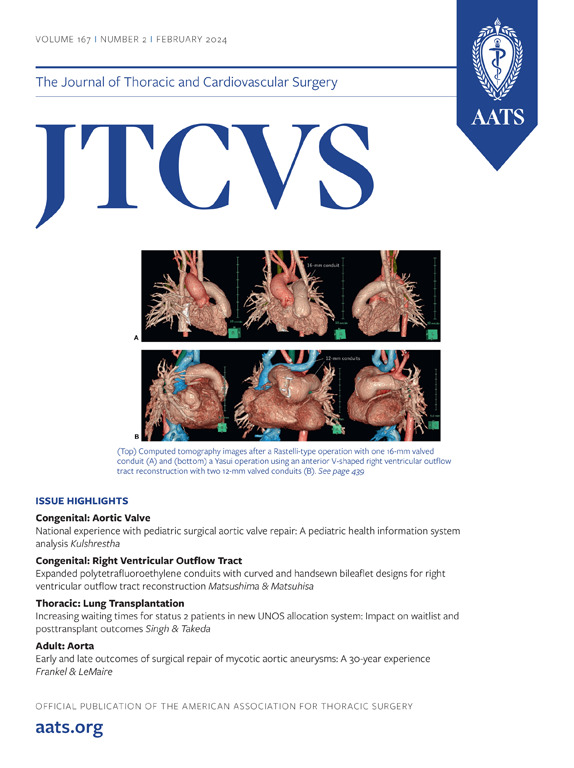The performance of a new nanosecond pulsed-field ablation surgical clamp in the ablation of cardiac tissue: A chronic porcine model
IF 4.4
1区 医学
Q1 CARDIAC & CARDIOVASCULAR SYSTEMS
Journal of Thoracic and Cardiovascular Surgery
Pub Date : 2025-10-01
DOI:10.1016/j.jtcvs.2024.11.036
引用次数: 0
Abstract
Objective
The purpose of this chronic porcine model is to demonstrate the safety and efficacy of a new nanosecond pulsed-field ablation (nsPFA) parallel clamp in ablating different cardiac tissue.
Methods
The Pulse Biosciences nsPFA CellFX Clamp System was tested on 6 pigs. Ablations were performed in all 4 heart chambers by delivering a sequence of very short-duration, high-amplitude electrical pulses taking 1.25 seconds per application independent of tissue thickness or type. Testing for electrical exit block was performed at the time of surgery and at study termination. At 35 days, animals were killed humanely and anonymized histopathology was performed to assess lesion width, depth, and transmurality. Lesion pattern and general safety were compared with 6 animals in which a bipolar radiofrequency clamp was used (AtriCure Synergy Isolator System).
Results
There were no device-related serious adverse events in the nsPFA group. There was 1 early device-related mortality at day 24 in the RFA group from perforation of 1 of the ventricular ablation sites. There were also 2 intracardiac thrombotic events with 1 systemic thromboembolic event in the radiofrequency group. Exit block was confirmed in all animals from both groups for the pulmonary veins and the posterior wall. Histologic findings were consistent and demonstrated mature scar formation in all nsPFA ablation specimens, whereas a 7.1% rate of incomplete histopathological scar maturation was present in the RFA group.
Conclusions
In this chronic porcine model, a single 1.25-second application independent of tissue thickness with the CellFX Parallel Clamp System demonstrated promising safety and efficacy profile. All lesions produced by this technology resulted in persistent exit block around pulmonary veins and the posterior atrial wall consistent with a reliable, contiguous and transmural ablation without injury to adjacent organs.
一种新型纳秒脉冲场消融手术钳在猪慢性心脏组织消融中的表现。
目的:建立猪慢性心脏模型,验证新型纳秒脉冲场消融(nsPFA)平行钳消融不同心脏组织的安全性和有效性。方法:采用Pulse Biosciences公司的nsPFA CellFX夹钳系统对6头猪进行试验。消融在所有四个心脏腔内进行,通过提供一系列非常短持续时间的高振幅电脉冲,每次应用时间为1.25秒,与组织厚度或类型无关。在手术时和研究结束时进行电出口阻滞测试。在第35天,对动物实施安乐死,并进行匿名组织病理学检查以评估病变的宽度、深度和跨壁性。病变模式和一般安全性与使用双极射频钳(AtriCure Synergy Isolator System)的6只动物进行比较。结果:nsPFA组无器械相关严重不良事件发生。RFA组在第24天有一例早期装置相关死亡,原因是其中一个心室消融部位穿孔。在射频组也有2例心内血栓形成事件和1例全身血栓栓塞事件。两组所有动物的肺静脉和后壁均出现出口阻滞。组织学结果一致,在所有nsPFA消融标本中均显示成熟瘢痕形成,而RFA组中存在7.1%的不完全组织病理学瘢痕成熟。结论:在慢性猪模型中,与组织厚度无关的CellFX平行钳系统单次1.25秒应用显示出良好的安全性和有效性。该技术产生的所有病变都导致肺静脉和后心房壁周围持续的出口阻塞,这与可靠的、连续的、跨壁的消融一致,且不损伤邻近器官。
本文章由计算机程序翻译,如有差异,请以英文原文为准。
求助全文
约1分钟内获得全文
求助全文
来源期刊
CiteScore
11.20
自引率
10.00%
发文量
1079
审稿时长
68 days
期刊介绍:
The Journal of Thoracic and Cardiovascular Surgery presents original, peer-reviewed articles on diseases of the heart, great vessels, lungs and thorax with emphasis on surgical interventions. An official publication of The American Association for Thoracic Surgery and The Western Thoracic Surgical Association, the Journal focuses on techniques and developments in acquired cardiac surgery, congenital cardiac repair, thoracic procedures, heart and lung transplantation, mechanical circulatory support and other procedures.

 求助内容:
求助内容: 应助结果提醒方式:
应助结果提醒方式:


